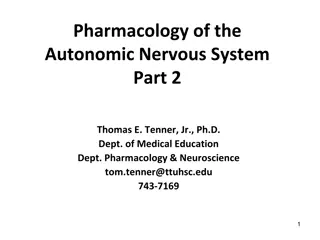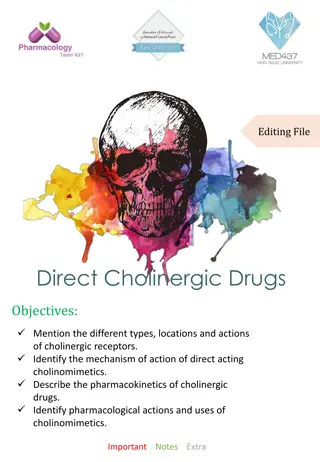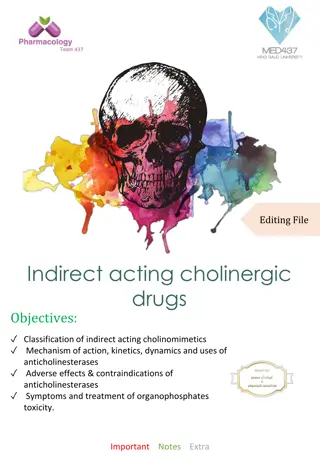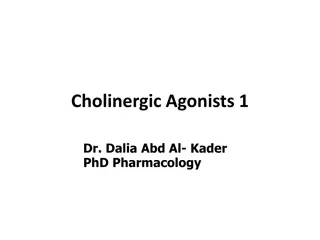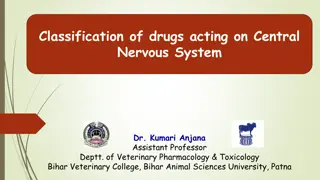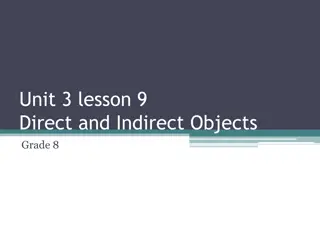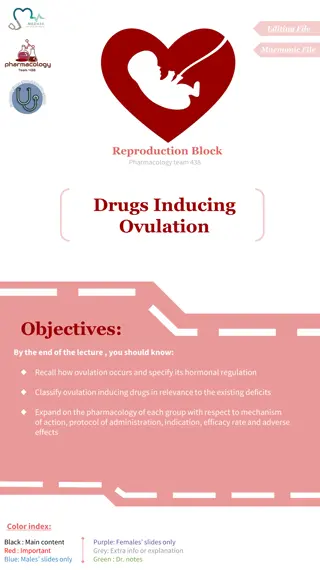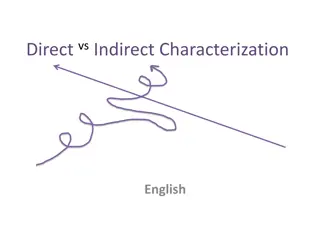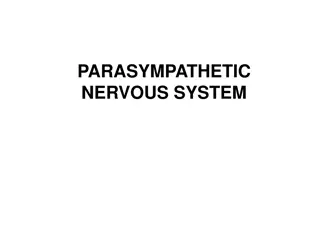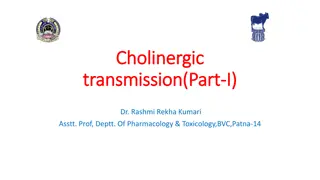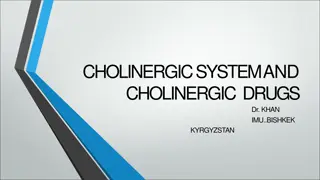Understanding Indirect-Acting Cholinergic Drugs and Their Mechanisms of Action
This lecture covers the classification, mechanism of action, kinetics, dynamics, and uses of indirect-acting cholinomimetics. It discusses anticholinesterases, their adverse effects, contraindications, and the symptoms and treatment of organophosphates toxicity. Reversible and irreversible anticholinesterases, along with their structures and functions, are also explained in detail.
Download Presentation

Please find below an Image/Link to download the presentation.
The content on the website is provided AS IS for your information and personal use only. It may not be sold, licensed, or shared on other websites without obtaining consent from the author. Download presentation by click this link. If you encounter any issues during the download, it is possible that the publisher has removed the file from their server.
E N D
Presentation Transcript
INDIRECT ACTING CHOLINRTGIC DRUGS Ali Alhoshani ahoshani@ksu.edu.sa http://fac.ksu.edu.sa/ahoshani Office: 2B 84
Objectives By the end of this lecture the student should able to : Classification of indirect acting cholinomimetics Mechanism of action, kinetics, dynamics and uses of anticholinesterases Adverse effects & contraindications of anticholinesterases Symptoms and treatment of organophosphates toxicity.
Parasympathomimetic/ cholinomimetics (Cholinergic Drugs )
Indirect-acting on Ach receptors (also called anticholinesterases) Mechanism of action: Anticholinesterases prevent hydrolysis of Ach by inhibiting acetyl cholinesterase thus increase Ach concentrations and actions at the cholinergic receptors (both nicotinic and muscarinic).
Indirect-acting on Ach receptors Mechanism of action : Normally
Indirect-acting on Ach receptors Reversible anticholinesterases Short acting (Alcohols) edrophonium Intermediate acting (Carbamates esters) Physostigmine, Neostigmine, Pyridostigmine Irreversible anticholinesterases Long acting Phosphates esters e.g. insecticides, gas war e.g. Ecothiophate & Isoflurophate
Indirect-acting on Ach receptors Structure: (Reversible anticholinesterases) 1- Simple alcohols ( Short Acting ) Forms weak hydrogen bond with acetylcholinesterase enzyme
Indirect-acting on Ach receptors Structure (Reversible anticholinesterases) 2- Carbamic acid esters (Intermediate acting) binds to two sites of cholinesterase enzyme All polar and synthetic except physostigmine Physostigmine Pyridostigmine Neostigmine pyridostigmine
Indirect-acting on Ach receptors Structure: Irreversible anticholinesterases 3- Organic derivatives of phosphoric acid ( Long Acting) used as insecticides(malathion) or nerve gases (sarin) Form very stable covalent bond with cholinesterase All phosphates are lipid soluble except ecothiophate which is polar. e.g. Ecothiophate Isoflurophate
Pharmacological effects of anticholinesterases ALL Anticholinesterases Action on Yes/No muscarinic YES nicotinic YES CNS effects only lipid soluble drugs
Pharmacological effects of anticholinesterases Nicotinic actions Neuromuscular junction Therapeutic dose: muscle contraction Toxic dose: relaxation or paralysis of skeletal muscles. Ganglia: stimulation of sympathetic and parasympathetic ganglia Adrenal medulla release of catecholamines (A & NA).
Pharmacological effects of anticholinesterases Muscarnic actions Cholinergic actions Contraction of circular muscle of iris (miosis)(M3) Contraction of ciliary muscles for near vision (M3) Decrease in intraocular pressure bradycardia ( heart rate ) (M2) Release of NO (EDRF) Constriction of bronchial smooth muscles Increase bronchial secretion M3 Increased motility (peristalsis) Increased secretion Relaxation of sphincter M3 Contraction of muscles Relaxation of sphincter M3 Increase of sweat, saliva, lacrimal, bronchial, intestinal secretions M3 Organs Eye Heart endothelium Lung GIT Urinary bladder Exocrine glands
Drugs indirect-acting on Ach receptors (CHOLINOCEPTORS) Edrophonium Reversible anticholinesterase alcohol Polar NOT absorbed orally (given by injection) attach mainly to acetyl cholinesterase by weak hydrogen bond. Has short duration of action (5-15 min.) Used for diagnosis of myasthenia gravis.
Drugs indirect-acting on Ach receptors (CHOLINOCEPTORS) Physostigmine Reversible anticholinesterase Tertiary ammonium compound Non polar (lipid soluble) Good lipid solubility Good oral absorption Has muscarinic & nicotinic actions cross BBB (has CNS effects) Uses Glaucoma atropine toxicity (atropine is anticholinergic drug)
Drugs indirect-acting on Ach receptors (CHOLINOCEPTORS) Neostigmine Reversible anticholinesterase Quaternary ammonium comp. Polar compound Can be used orally No CNS effect Has muscarinic & nicotinic actions (prominent on GIT & urinary tract). Uses Treatment of myasthenia gravis Paralytic ileus & Urinary retention Competitive neuromuscular blockers intoxication
Drugs indirect-acting on Ach receptors (CHOLINOCEPTORS) Drug Actions Nicotinic & muscarinic M, N Kinetics Uses Neostigmine Myasthenia gravis treatment Paralytic ileus Urinary retention Curare toxicity Glaucoma atropine toxicity 0.5-2hr polar 0.5-2hr Lipid soluble Physostigmine Nicotinic muscarinic M, N, CNS Nicotinic & muscarinic M, N Nicotinic & muscarinic M, N Pyridostigmine 3-6 polar Myasthenia gravis treatment Ambenonium 4-8 polar Myasthenia gravis treatment
Drugs indirect-acting on Ach receptors (CHOLINOCEPTORS) Ecothiophate (Organophosphorous compounds) Irreversible anticholinesterase Binds to cholinesterase by strong covalent bond. Have very long duration of action Aging make bond extremely stable Not lipid soluble Used for glaucoma.
Drugs indirect-acting on Ach receptors (CHOLINOCEPTORS) Organophosphates toxicity Heart: Lung: GIT: CNS: Skeletal muscles :
Drugs indirect-acting on Ach receptors (CHOLINOCEPTORS) OXIMES Pralidoxime (PAM) cholinesterase reactivator Acts by regeneration of cholinesterase enzyme. reactivates recently inhibited enzymes before aging. Uses I.V. over 15-30 min for organophosphate intoxication.
Drugs indirect-acting on Ach receptors (CHOLINOCEPTORS) Donepezil Anticholinesterase drugs. Given orally. used for treatment of dementia of Alzheimer s disease
Drugs indirect-acting on Ach receptors (CHOLINOCEPTORS) Edrophonium M, N Neostigmine M, N Very Short 5-15 min, Polar Short 0.5-2hr polar Diagnosis of Myasthenia gravis Myasthenia gravis treatment Paralytic ileus Urinary retention curare toxicity Glaucoma atropine toxicity Myasthenia gravis treatment Physostigmine M,N, CNS Ambenonium Pyridostigmine M, N Ecothiophate M, N Short 0.5-2hr Lipid soluble Short 3-6, polar Long 100hr, polar Glaucoma. Donepezil M, N dementia of Alzheimer s disease
Summary for cholinomimetics & their uses Eye : treatment of glaucoma Pilocarpine (direct muscarinic agonist) Physostigmine Ecothiophate (indirect cholinomimetics) Urinary retention and paralytic ileus Bethanechol (direct) Neostigmine (indirect) Myasthenia gravis (only indirect cholinomimetics) Pyridostigmine, Neostigmine, Ambenonium Xerostomia Pilocarpine Cevimeline (Sjogren s syndrome) Alzheimer s disease: Donepezil
Drugs indirect-acting on Ach receptors (CHOLINOCEPTORS Adverse effects of cholinergic drugs: Bradycardia Sweating & Salivation Bronchoconstriction Diarrhea Contraindications of cholinergic drugs Bronchial asthma Peptic ulcer Angina pectoris Incontinence Intestinal obstruction
Drugs in/direct-acting on Ach receptors Adverse effects: In mid-afternoon, a coworker brings 43-year-old JM to the emergency department because he is unable to continue picking vegetables. His gait is unsteady and he walks with support from his colleague. JM has difficulty speaking and swallowing, his vision is blurred, and his eyes are filled with tears. His coworker notes that JM was working in a field that had been sprayed early in the morning with a material that had the odor of sulfur. Within 3 hours after starting his work, JM complained of tightness in his chest that made breathing difficult, and he called for help before becoming disoriented.
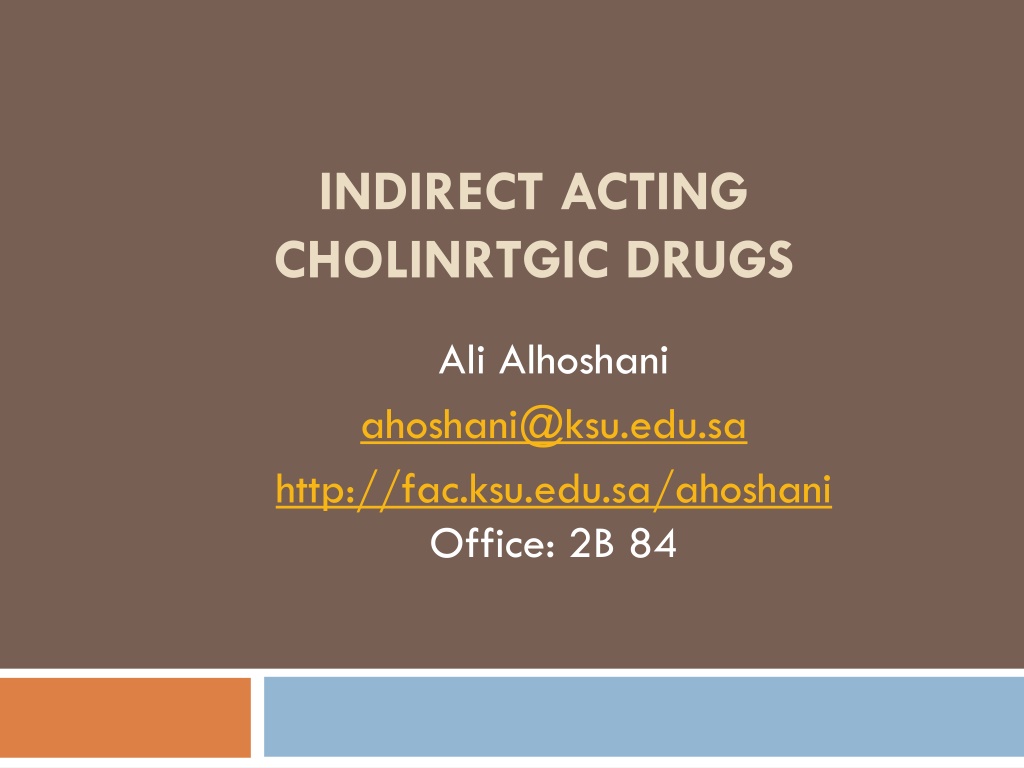
 undefined
undefined






